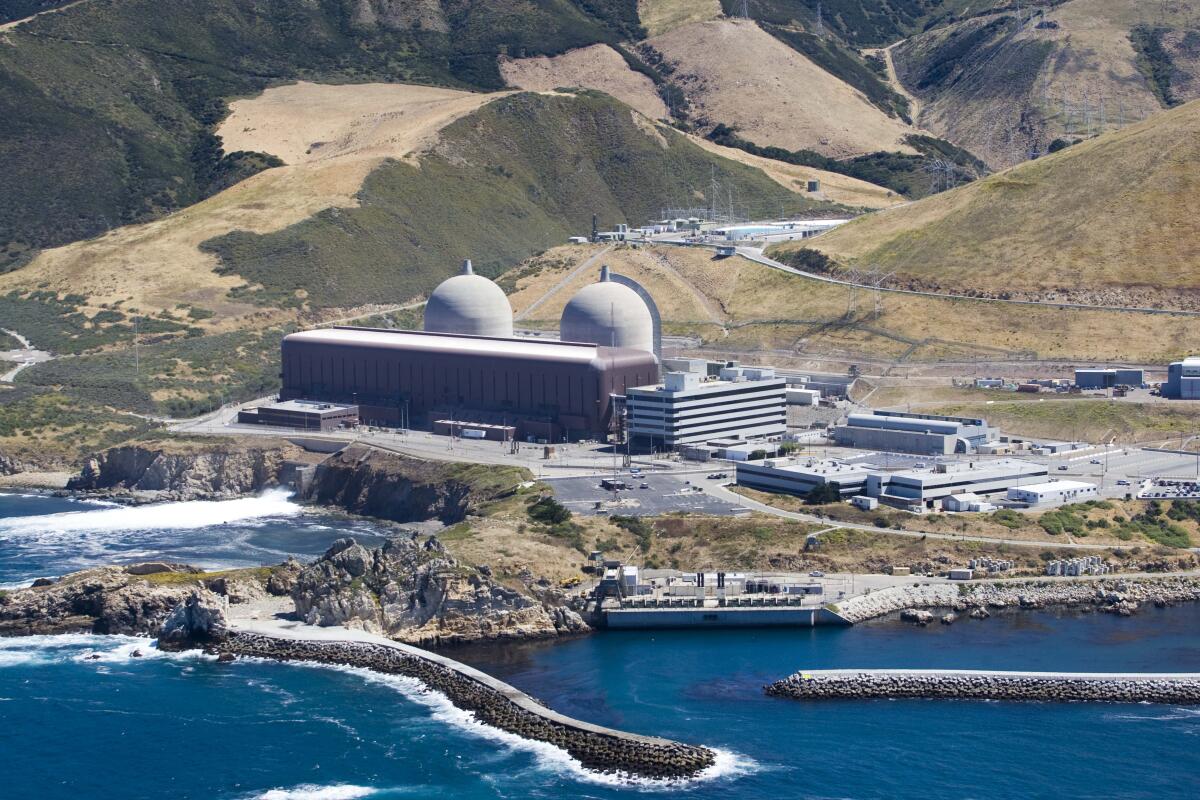Keeping California’s last nuclear power plant open could help state meet its climate goals, study says

- Share via
SAN DIEGO — Keeping the last remaining nuclear power plant in California open can help the state achieve its climate goals and save more than $2 billion, according to a 114-page assessment compiled by a joint study team from Stanford University and MIT.
But Pacific Gas & Electric, the operator of the Diablo Canyon Power Plant, says it still plans to close the facility starting in three years, and longtime critics of nuclear power remain firmly opposed to any talk of extending the life of the power plant that overlooks the Pacific in Central California.
The study’s eight authors acknowledge the report’s proposals would need to clear plenty of hurdles to become reality but say the assessment should prompt discussion as California continues the delicate balancing act of meeting its climate goals while making sure the electric grid is reliable and affordable.
Doing all that, the report says, means placing an increasingly higher value on what’s called “low-carbon firm capacity,” energy that’s not intermittent but available whenever it’s needed while emitting at most negligible amounts of greenhouse gases.
“And that value becomes higher as you drive down to really deeply decarbonized scenarios,” said Jacopo Buongiorno, professor of nuclear science and engineering at MIT. “Nuclear plants — and Diablo Canyon is no exception — are one such clean and firm [source of] power capacity that we think should be preserved.”
The report analyzed various scenarios and concluded that keeping Diablo Canyon running would “significantly reduce California’s use of natural gas for electricity” and save $2.6 billion in costs to the state’s power system from 2025 to 2035. The 2,240 megawatts of electricity generated by the plant can also help grid operators avoid blackouts, such as the statewide outages experienced in August 2020.
The assessment has earned the endorsement of Steven Chu, secretary of Energy during the Obama administration and a Stanford physics professor.
“We are not in a position in the near-term future to go to 100% renewable energy, and there will be times when the wind doesn’t blow, the sun doesn’t shine and we will need some power that we can actually turn on and dispatch at will,” Chu said during a webinar Monday unveiling the Stanford/MIT assessment.
That leaves two choices, Chu said — using fossil fuel resources or nuclear. “I believe that nuclear presents a very good option,” he said, “especially nuclear power plants that have been built.”
When the San Onofre Nuclear Generating Station stopped producing electricity in 2012 after a leak in a steam generator tube led to its closing, Diablo Canyon became the last remaining nuclear power plant in California. Diablo has been producing electricity since the mid-1980s.
By itself, the plant each year accounts for 8% to 9% of California’s in-state electricity generation and overall power mix.
But in 2016, PG&E made headlines by announcing it would no longer seek a 20-year license extension for the plant. Instead, the utility reached an agreement with a collection of environmental and labor groups to shut down the plant, saying Diablo will become uneconomical to run due to the growth of renewable energy sources, increased energy efficiency measures and the migration of customers from traditional utilities such as PG&E to community choice energy programs.
The California Public Utilities Commission approved the proposed shutdown in 2018. Unit 1 is set to close in 2024, and Unit 2 is scheduled to go offline in 2025.
Since the announcement, California has accelerated its climate goals. It now aims to derive 60% of its electricity from renewable sources by 2030 and 100% from carbon-free sources by 2045. This year, Gov. Gavin Newsom called on the Air Resources Board to look into moving up the 2045 target to 2035.
“A lot has changed since the time the decision to shut down Diablo Canyon was made,” Buongiorno said, and those decisions led to the formation of the joint study.
In addition to the prospect of keeping the nuclear plant open, the assessment also looked at additional uses for Diablo Canyon:
- The plant already has a small desalination plant on-site that takes in seawater to help operate Diablo. The Stanford/MIT report suggests building a much larger desalination plant that would be located alongside Diablo. The nuclear plant would power the desalination facility and then send the treated water to areas in the state parched by the long-running drought.
- Another option would take Diablo Canyon and the proposed desalination plant to produce hydrogen, an element increasingly seen as a way to help decarbonize polluting sectors such as transportation and manufacturing. The report estimated that allocating 22% of Diablo’s total capacity would yield 109 million kilograms of hydrogen per year. California’s projected demand for hydrogen in 2025 ranges from 500 million to 1.2 billion kilograms.
The capital expenditure for the least expensive option for the proposed desalination plant would be $599 million, but the study estimates that would be half the cost of a desalination plant the size of the one currently operating in Carlsbad.
The estimated capital cost for the proposed hydrogen facility would come to $335.3 million.
On top of those expenses, any continuation of operations at Diablo Canyon would also require a very expensive retrofit. The plant uses water from the ocean in a process called “once-through cooling” that can kill marine life. California requires existing power plants to decrease their intake flow rate by 93%. The assessment estimates it would cost $500 million to install a system that meets state code.
Despite those expenses, the report says keeping Diablo Canyon open makes financial sense.
For example, the authors predict that if Diablo is closed, a carbon-free electrical system in California in 2045 would need 18 gigawatts of photovoltaic (PV) solar and 11 gigawatts of energy storage. The additional capacity of solar to replace Diablo Canyon, the report says, would take up 90,000 acres of land. By comparison, the footprint at Diablo is just 900 acres — and only 140 acres for the plant itself.
On a shorter horizon, the report says that if Diablo Canyon stays open, the state’s power grid would not need to install an additional 3.4 gigawatts of PV and 2.7 gigawatts of energy storage in 2025 and 2030.
“The state is going to need to build a lot of [renewable] capacity, and what we’re finding is that the deployment rate has to be much higher than what it is today,” said Ejeong Baik, one of the report’s co-authors and a doctoral candidate in the Department of Energy Resources Engineering at Stanford. “Diablo Canyon really just helps reduce that burden on the state…. We’re not saying it’s Diablo Canyon versus PV. It’s really going to have to be all of the above.”

PG&E received a briefing on the assessment, but the utility remains firm: Diablo Canyon’s scheduled closure remains in place.
“PG&E is committed to California’s clean energy future, and as a regulated utility, we are required to follow the energy policies of the state,” senior manager of communications Suzanne Hosn said in a statement. “The state has made clear its position on nuclear energy and the plan to retire Diablo Canyon Power Plant has been approved by the California Public Utilities Commission and the state legislature. Our focus, therefore, remains on safely and reliably operating the plant until the end of its NRC licenses, which expire in 2024 and 2025.”
Environmental groups that took part in the negotiations that led to the 2016 agreement say it’s time for the state to close the door on nuclear power and dismissed the report.
“This is clearly the product of academics in an ivory tower who have no sense of the reality down on the ground,” said David Weisman, outreach coordinator for the Alliance for Nuclear Responsibility. Weisman said any plans to relicense Diablo Canyon would be met with vocal opposition and said the report’s estimate of $500 million to fix the once-through cooling process is much too low.
“The plant is already 40 years old,” Weisman said. “It has the risk of increasing problems as the plant ages” and the operator of the facility would to need to spend significant sums for upgrades. In 2020, PG&E reported problems with the main generator system at Unit 2, which led to at least a pair of temporary shutdowns of the unit.
John Geesman, a former executive director of the California Energy Commission and staff attorney for the Alliance for Nuclear Responsibility, panned the Stanford/MIT assessment and scoffed at its proposal to produce hydrogen.
“This would be more credible if these academics represented a developer with several hundred million dollars needed to take this fantasy through the permitting process,” Geesman said. “Licensing a Hindenburg-type explosive technology next to a nuclear plant surrounded by earthquake faults is not for the faint-hearted.”
Report co-author Buongiorno said the NRC recently completed a review that determined Diablo Canyon could withstand even the most severe earthquake. As for PG&E’s refusal to reconsider, Buongiorno said perhaps another utility or energy company would be interested in purchasing the plant.
“We are not making recommendations or suggesting a policy,” Buongiorno said. “However, the numbers we have produced and the analysis that we have run we feel are pretty compelling. It’s showing a lot of value here. So I think it would be reasonable for California to reconsider the decision to shut [Diablo Canyon] down.”
Baik of Stanford said the report acts as a “great conversation starter.”
“We’re not trying to end the debate, saying this is the final be-all,” she said. “But it’s worth at least opening this discussion again and seeing what people have to say.”
And when it comes to nuclear energy, many don’t lack for an opinion.
More to Read
Sign up for Essential California
The most important California stories and recommendations in your inbox every morning.
You may occasionally receive promotional content from the Los Angeles Times.











